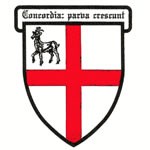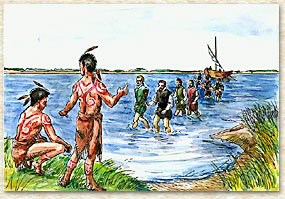
Philip Amadas and Arthur Barlowe's reconnaissance of the North American coast was, like the driving of the golden spike, a pivotal episode in American history. The first known published reference to the voyage appeared in Holingshed's Chronicles in 1587. The most extensive account, written by Barlowe was published in 1589, in Hakluyt's Principal Navigations. Both narratives were clearly designed to promote an interest in Ralegh's colonizing efforts. While there is no concrete evidence that Barlowe suppressed unpleasant details, there are indications that he distorted the picture of his contact with the Native Americans. Barlowe, and certainly Ralegh and Hakluyt wanted to entice settlers and backers. In order to do so, they depicted a near-idyllic people, who were ready to receive and trade with English explorers and colonists. In a similar vein, the two most famous interpretations of this beginning of English America were also designed to stimulate travel to and trade with coastal North Carolina. Mabel Evans Jones's 1921 silent film contained the first dramatic representation of the arrival of the English. Shortly thereafter, in 1937, Paul Green expanded the scene in this drama The Lost Colony. With similar goals, albeit different techniques, the play, film, report and chronicle all cloud the reality of the events, and distort the facts to fit the tenor of their times — from Elizabethan England, to the 1920s and Depression-era America. Chronology of the 1584 Voyage 25 March 1584Walter Ralegh was granted a royal patent to colonize any new lands in the name of the crown. 27 April 1584 10 May 1584 10 June 1584 2 July 1584 4 July 1584 4 July 1584 through 13 July 1584 13 July 1584 13 July 1584 through mid August 1584 The next day, an English delegation was received by Granganimeo (brother of the King), who according to Barlowe, "...came along to the place [on the shore] over against the ships, followed with forty men. When he came to the place, his servants spread a long mat upon the ground, on which he sat down, and at the other end of the mat, four others of his company did the like: the rest of his men stood round about him, somewhat afar off: when we came to the shore to him with our weapons, he never moved from his place, nor any of the other four, nor never mistrusted any harm to be offered from us, but sitting still, he beckoned us to come and sit by him, which we performed: and being set, he makes all signs of joy, and welcome, striking on his head, and his breast, and afterwards on ours, to show we were all one, smiling, and making show the best he could, of all love, and familiarity." 
Vicki Wallace The Englishmen presented Granganimeo with gifts, and a day or two after their having established friendly relations with him, trading began. Soon, large numbers of Indians from many areas came to the harbor to trade. Granganimeo supplied the explorers with food, visited their ships and once even dined aboard. The Englishmen tested the soil by planting peas, and after the trading period had been completed, explored 20 miles of the River Occam (Pamlico Sound). In the evening following their Occam exploration, Amadas and Barlowe and some of their men traveled to Roanoke Island where they saw Granganimeo's wife. She invited them to the village, refreshed them and served them a meal in her own home. Barlowe recalled: "We were entertained with all love, and kindness, and with as much bounty, after their manner, as they could possibly devise. We found the people most gentle, loving, and faithful, void of all guile, and treason, and such as lived after the manner of the golden age." August 1584 (no date cited) Chronology and text by lebame houston and Wynne Dough. All dates O.S. Spelling in the direct quotations has been modernized, but the punctuation has been retained.
|
Last updated: April 14, 2015
